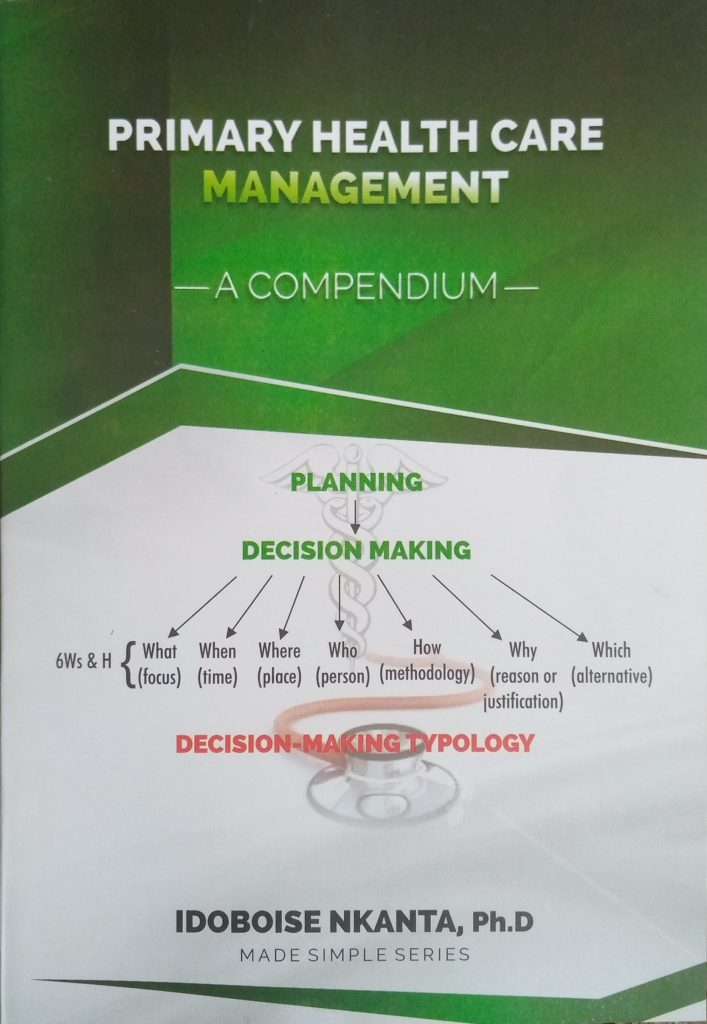Book Review
Title : Primary Health Care Management A Compendium
Author : Idoboise Nkanta, Ph.D
E Mail : therightlegend@gmail.com
Place of Publication : Uyo
Publisher : Modern Business Press Ltd
Year of Publication : 2021
Number of Page : xiv+169= 183
Price : Not Stated
Reviewer : Emmanuel Ntekim
Introduction Purpose of the Book
Management is often viewed as difficult task in families and organizations or institutions due to lack of access to relevant literatures to explain the how-to-do- process. Research has shown that the divorce rate in our society today is the failure of husbands and wives to achieve effective management skills in their homes.
Studies again, tells us that leaders of our most important institutions and professions are out of touch with the people, the very ones they are supposed to lead or help. Therefore, it is not far-fetched in the health care delivery system. There is a serious gap that has been neglected in the health care centres the patients and system management and administration, most especially with many changes in our society and behavioural attitudes of people, however, through effective management techniques with right situations, expected goals and objectives of organizations and establishments can be achieved.
As adjudged in the preface of this book, the compendium addresses many of the questions often asked by health workers without holistic and empirical response from Trainers / Lecturers. New horizons often ignored by amateur writers Meeting Procedures, Cadre Interpersonal Relationship, Staff Management, Inter and Intra Relationship, Health Planning Methodology, Record Keeping, Filing System etc. is a gratifying paradigm shift from adjunctival juxtaposing of many or all courses in (PHC) in just one or two volumes that fails to cover even the fundamentals of each of such courses.
The book Primary Health Care Management A Compendium is what could be called a collection of corroborate ideas in a book that is set out to corroborate character traits, systemic dysfunction that result in poor service delivery at the various level of health posts in our nation.
This book has attempted to amplify management in primary health care, addresses the dysfunctional and structural lacuna, imbalance in the health staff and patient relationship. It is what-and-how-to-do book tailored to meet the needs of all Primary Health Care Practitioners and students-in-learning, who are desirous of functional skills before and after graduation(p. vii). Since change as earlier said is constant, this book is a tutored to adapt to the management techniques that match with the change. It is a sine-quo-non for good and effective management of health care establishment which will in turn enhance output that is needed for development and mutual relationship for optimum benefit.
Organization of Contents
Contents of the book range from the essence and function of management, decision making, organizing, delegation, motivation and control, supervision, record keeping, conducting staff meeting and how to organize workshop for training of health personnel. These are organized in distinct but related chapters.
The book has a prologue and epilogue with sixteen chapters. Chapter one deals with the essence of management, chapter two with functions of management, chapter three, decision making and four with organizing (or coordinating). Chapter five focuses on leading (or motivation), chapter six on delegation, chapter seven on motivation, eight on control and nine on supervision. Chapter ten concerns with management by objective, eleven on record keeping, twelve with budgetary control while thirteen deals with conducting staff meeting procedure. Chapter fourteen focuses on health planning, fifteen concerns with primary health care management structure (level of PHC development), while sixteen deals with how to organize workshop for training of health personnel.
Chapter one explore the concept and some definition of management, seeing management as a practice in government, nongovernmental organizations, unions, churches, businesses and social organized engagements. It sees the position of a manager as a person who is to provide dynamic force, leadership and direction for attainment of envisaged objectives.
Chapter two acknowledges four principal functions of management namely: planning, organizing, directing and control. Planning is explained as a process of deciding what to do, when, where, how and why. It includes making decision now, based on current facts and forecasting of future trend of events. It views good planning as realistic and capable of implementation, being accurate, clear and precise with quantitative and qualitative targets set that must be comprehensive to enhance coordination.
Chapter three titled decision making, sees decision making as ongoing process of evaluating, considering alternatives, making a choice and then following up with the necessary action. As a result, it is goals oriented, it occurs in sequential chain, and also occurs over a period of time punctuated by events which influences the final outcome. The chapter elucidates four decision making styles: directive style -focus on the short-run rather than on the long run since managers of this style have low tolerance for ambiguity and rational way of thinking with lack of confidence on subordinates, analytical style characterized by high tolerance for ambiguity and a rational way of thinking. Conceptual style is a decision characterized by high tolerance for ambiguity and intuitive way of reasoning. This involves looking through the broader outlook of alternatives before deciding.
The behavioural style on the other hand, takes a low tolerance for ambiguity and intuitive way of reasoning -managers here are interested in the participation of the employees. However, intelligence, cautiousness, risk taking, optimism/pessimism, ego defensive, level of expectation, decisiveness and credibility are the personal traits of decision makers/managers (p. 15). Decision Making is without factors affecting it. The author in chapter three grouped the explanation into three dimensions: organizational constraints, psychological thought process and personality variables. In chapter four, the rudiments of organizing or coordinating are clearly explained. The organizations and coordination deals with people; the type of work (type of staff) and sphere of job description.
The organizing or coordinating is effective through leadership. This is the discourse on chapter five. It treats leadership, types: autocratic, democratic, persuasive, consultative and Laissez faire. Chapter six covers delegation which is acknowledged as transcending almost all functions of management whether directing, leading, coordinating and organizing. The reason lies on the premise that delegation is the transfer of authority from a supervisor to a subordinate in relation to duties or duty assigned to him. It treats barriers to effective delegation, merits and demerits of delegation, limitations and powers that should not be delegated.
For any organization leader to succeed and achieve the organizational or leadership goals, there are indices that trigger or act as an enforcement that is not coercive in nature, which is motivation.
Chapter seven treats motivation. Motivation is a creation of high morale or working spirit within individuals or groups toward the attainment of goals and objectives. The cycle of motivation pulls illustrated by the author explains that needs, wants and desires energized individual and make him determine and direct his thoughts to his behaviour, which also make up his personality and learning experiences. The chapter demonstrated three features of motivational attributes, ways to motivate and in-depth explanation to Maslow’s hierarchy of needs theory.
Chapter eight covers control, forth main functions of management. It views control in the aspect of monitoring and modification of organizational activities to pre-determined standards and plans carried out. There are merits and demerits of control with characteristics, but the essence are the three types of control any manager should know: feed forward, feedback and concurrent entailing preventive, reactive if damage are done for corrective action and close supervision to detect non-conforming or conforming action(s).
In would have been improper if supervision treated in chapter nine didn’t follow chapter eight control, because the two needs to work side-by-side. Apart from the good qualities of supervision explained in the book, the types of supervision are paramount: direct or simple supervision, indirect, plural (on the spot or job assessment), distant or peripheral supervision.
Chapter ten treats Management by Objective (MBO). As noted by the author, MBO is a goal-setting and not a measurement of employees behaviour. The essence is to measure employees effectiveness or contribution to organizational success and attainment. Most problems experienced by PHC administrators are direct result of inadequate managerial skills but the management principles of Fayol’s in this chapter, will go a long way to address the systemic dysfunction of PHC managers.
Chapter eleven shows the proper and essential way of record keeping, the advantages and disadvantages. It covers time keeping records, duty roster and how to make a duty roster. The chapter precedes budgetary control as chapter twelve. It show how budgets can help managers coordinate resources and projects, provides clear guidelines about organization resources and expectations.
Chapter thirteen unbundled all the necessary facts, steps and appropriate methods in health planning. It sees health planning as a daily and continuous process borne out of new and emerging circumstances which may not have been envisaged. The explanation of health planning as treated by the author in this chapter are among others, to provide appropriate guides for work flow, eliminate waste of available resources and facilitate health care fore-casting and pre-emptive action.
Chapter fourteen shows and covers the proper way of conducting staff meetings. It explains several procedures from quorum, agenda to adjournment and closing prayer. Chapter fifteen focuses on the primary health care management structure, from the village to ward, to district, local government to national with notes on their operational guidelines. While chapter sixteen treats how to organize workshop for training of health personnel. The authors’ discourse makes the managers of PHC and the readers look as if he/ she is already in a workshop with checklist tools and specimens of active participation to indicate the extent to which he/she agree or disagree with each questions raised.
Evaluation and Conclusion
The book provides ample information and examples in Primary Health Care Management. Since management is universal, the book will help neophytes, professional “bandits” and interlopers who thoroughly and strategically find themselves in the PHC management space to shape their physio-psychological behaviours toward addressing the absurdity in the management functions.
Technically, the book is well finished with legible print on pages with generous margin. The book is an important contribution to the teaching and learning of management universally and in health care system in Nigeria. I strongly recommend this text to the reading public in general, managers and students of other fields and health profession in particular. It promises to be a helpful companion indeed. No PHC managers and students should miss this book rush now!

THE ROTTEN FISH: CAN OF WORMS OPENED OF APC & TINUBU'S GOVERNMENT OVER NIGERIA'S ECONOMIC DOWNTURN
WATCH THE CRITICAL ANALYSIS AND KNOW THE RESPONSIBLE PARTIES TO BLAME FOR NIGERIA'S ECONOMIC CHALLENGES, WHILE CITIZENS ENDURE SEVERE HARDSHIPS.Watch this episode of ISSUES IN THE NEWS on 9News Nigeria featuring Peter Obi's Special Adviser, Dr Katch Ononuju, 9News Nigeria Publisher, Obinna Ejianya and Tinubu Support Group Leader, McHezekiah Eherechi
The economic crisis and hardship in Nigeria are parts of the discussion.
Watch, leave your comments, and share to create more awareness on this issue.
#9NewsNigeria #Nigeria #issuesInTheNews #politics #tinubu THE ROTTEN FISH: CAN OF WORMS OPENED ...
DON'T FORGET TO SUBSCRIBE AND LEAVE YOUR COMMENTS FOR SUBSEQUENT UPDATES
#9newsnigeria #economia #economy #nigeria #government @9newsng
www.9newsng.com
